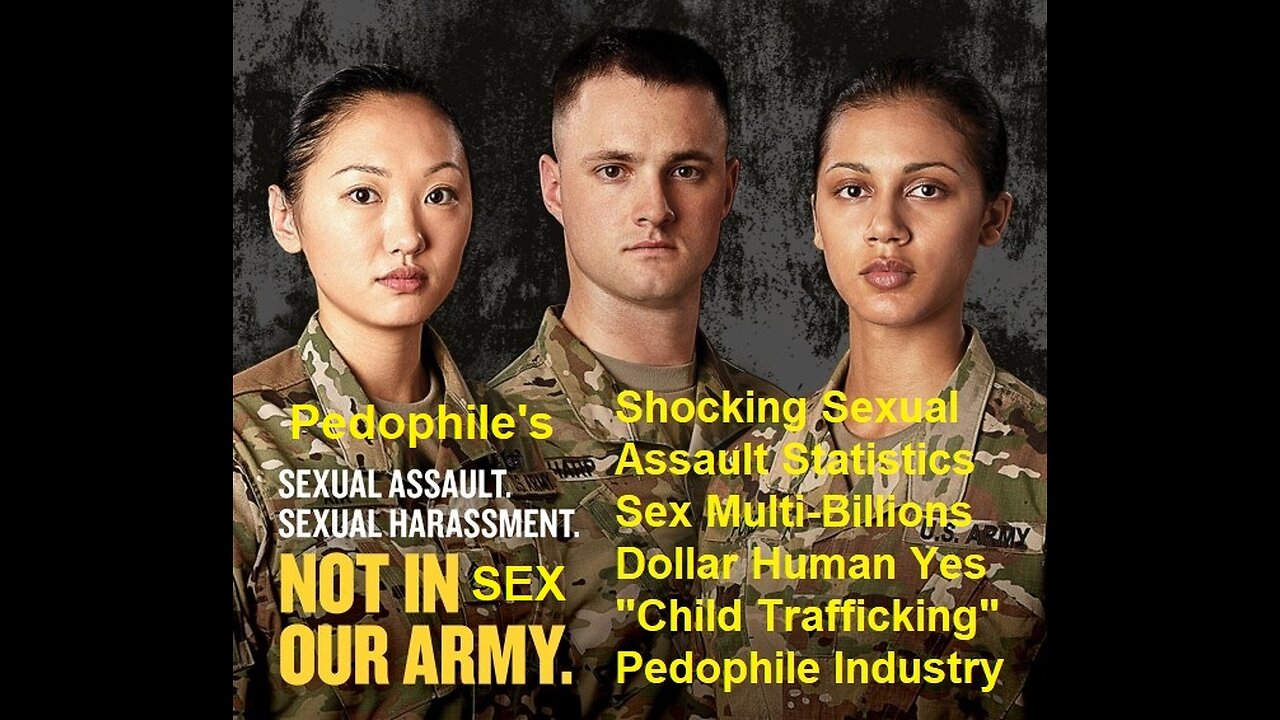Premium Only Content

Shocking Sexual Assault Statistics Sex Multi-Billion Dollar Human Trafficking Industry
Shocking Sexual Assault Statistics Sex In U.S. Military and 4 All 50 State's Rape Too. Continues to expand on the progress it has made in serving the needs of thousands of sexual assault victims. Now it's giving them a voice in the criminal investigation and prosecutorial systems. As part of the Army's and Navy's efforts to combat sexual assault in the ranks, it has developed the Special Victim Counsel Program to protect the rights of sexual assault victims. Special victims' counsels are specially trained military attorneys, duty-bound to work for no one but the victim.
Working with a robust support system of victim advocates and victim witness liaisons, a special victims' counsel ensures that victims fully understand their rights throughout the military investigative, judicial and legal administrative processes.
"It can be difficult to prosecute sex crimes in the military because of the fear of retribution and the stress of the judicial process; it can be too long and traumatic," said Capt. Renee Darville, Northern Law Center client services chief.
"So the Army and Navy's said, 'Let's give the victim an attorney. Let's give them a voice and agency to determine what level they want to participate in and help them feel more in control in the process.'"
According to the Department of Defense, victims must be confident that, should they report a sexual assault, they will be treated fairly. Part of that fair treatment is ensuring they know and can exercise their rights.
"I am an attorney specifically for the victim," Darville said. "I have 100 percent confidentiality. I am the victim's buffer and voice. I am here to help them heal, but also by building victims' trust in the system, we hope they'll be more willing to report offenders."
Last year, the Department of Defense received a total of 6,083 reports of sexual assault for allegations involving service members, according to the fiscal year 2015 Department of Defense annual report on sexual assault in the military.
Despite a substantial increase in reporting over the past 10 years, a significant number of sexual assaults still go unreported each year. Just 23 percent of the estimated 20,300 service member victims who indicated experiencing a sexual assault reported the crime.
Reasons for not reporting an incident of sexual assault that were cited by focus group participants included: negative reactions from peers, impact on reputation, and concerns for possible repercussions for collateral misconduct.
In response, the military now requires that victims reporting an assault be notified of their right to consult with a special victims' counsel and of the availability of other legal assistance. Victims must receive this explanation at the time they report a sexual assault.
In addition, no one in a victim's chain of command or the accused's chain of command may influence a special victims' counsel in providing legal support to a victim.
"Our efforts are having an impact, but there are still many hurdles to overcome," said Army Maj. Gen. Camille Nichols, director of the Department of Defense Sexual Assault Prevention and Response Office.
"Reporting the crime is essential for our ability to bring care and advocacy to survivors and hold offenders appropriately accountable."
Most respondents to the 2015 Military Investigation and Justice Experience Survey, which collected survivor feedback on the military justice process, reported that they were highly satisfied with the support they received, with 77 percent saying they would recommend other survivors come forward.
It is imperative that Army and Navy's leaders and Soldiers, especially sexual assault victims, have confidence in the military justice system, the annual report said. Instilling trust and inspiring victims to report sexual offenses will assist the military in achieving the cultural change it desires.
Until then?
"JAG is a safe space," Darville said. "People come to legal assistance every day for all kinds of reasons. So a victim does not have to worry about disclosing why they are here. People can access me without that fear." She added, "It is never too early or too late to reach out. I can support at any point in the process."
Statistics underscore the prevalence of violence in our communities. It is urgent that we stand up against domestic violence, sexual violence, human trafficking and child abuse:
Domestic violence statistics
A person is abused in the United States every 9 seconds; (Bureau of Justice Statistics)
On average, 3 women are killed by a current or former intimate partner each day in the United States; (Bureau of Justice, Bureau of Justice Statistics)
1 in 4 women have experienced severe physical violence by an intimate partner; (National Intimate Partner & Sexual Violence Survey)
1 in 4 victims of intimate partner violence identify as lesbian, gay, bisexual, transgender or queer; (National Coalition of Anti-Violence Programs)
66 percent of female stalking victims are stalked by a current or former intimate partner; (National Stalking Resource Center)
Domestic violence costs more than $8.3 billion a year in medical care, mental health services and lost productivity at companies; (Centers for Disease Control and Prevention)
More than 15 million children witness domestic violence each year in the United States; (Journal of Family Psychology)
3,500 to 4,000 children witness fatal family violence annually in the United States; (National Task Force on Children Exposed to Violence)
Sexual violence statistics
1 in 4 women and 1 out of 6 men are sexually abused in their lifetime; (Department of Justice)
In 8 out of 10 rape cases, the victim knows the attacker; (Department of Justice)
1 in 2 transgender individuals will experience sexual violence; (National Intimate Partner & Sexual Violence Survey)
1 in 4 bisexual women will experience sexual violence; (National Intimate Partner & Sexual Violence Survey)
2 in 5 gay men will be sexually abused; (National Intimate Partner & Sexual Violence Survey)
Nearly 6 out of 10 sexual assaults occur in the victim’s home or the home of a friend, relative or neighbor; (Department of Justice)
13.3 percent of college women say they have been forced to have sex in a dating situation; (Journal of Interpersonal Violence)
Only 28 percent of victims report their sexual assault to the police; (Bureau of Justice Statistics)
Only about 2 percent of all sexual assaults reported to police turn out to be false; (Department of Justice)
Among developmentally disabled adults, up to 83 percent of females and 32 percent of males are victims of sexual violence; (Disabled Women’s Network)
Child abuse statistics
A report of child abuse is made every 10 seconds; (American Society for the Positive Care of Children)
1 in 3 girls and 1 in 7 boys will be sexually assaulted by the time they reach 18; (Department of Justice)
More than 4 children die each day because of child abuse; (U.S. Department of Health and Human Services)
More than 90 percent of child sexual abuse victims know their attacker; (“Sexual Assault of Young Children as Reported to Law Enforcement” by Howard Snyder)
Approximately 70 percent of children that die from abuse are under the age of 4; (U.S. Department of Health and Human Services)
About 30 percent of abused and neglected children will later abuse their own children, continuing the cycle of violence; (U.S. Department of Health and Human Services)
Quick Facts about Sexual Assault in America – 2023 It is a sobering fact that sexual assault is one of the most prevalent crimes committed in American society. While a tremendous amount of work has been done in our culture to empower victims, hold perpetrators accountable, and remove the stigma around reporting an assault, statistics still point to a very troubling picture of sexual assault in America.
Every two minutes, an American is sexually assaulted. This is a staggering rate. This works out to an average of 237,868 victims of rape or sexual assault each year. To say there is a sexual assault crisis in our society may be a dramatic understatement, especially given that countless assaults go unreported each year.
Here is a look at how sexual assault is affecting society.
Fast Facts – The Scope of the Problem
Every 68 seconds, an American is sexually assaulted.
There are over 470,000 rape victims in America each and every year.
Young Americans are at the highest risk for sexual violence.
90% of adult rape victims are women.
1 in 2 women and 1 in 4 men experience sexual violence in their lifetime.
Around 81% of women and 43% of men experienced in their lifetime either sexual harassment, sexual assault, or both.
Approximately 74.9% of bisexual women, 43.3% of heterosexual women, and 46.4% of lesbians reported having experienced sexual violence at some point.
1 in 2 transgender Americans will experience sexual violence.
2 in 5 gay men will be sexually assaulted in their lifetime.
Only 2% of reported sexual assaults turn out to be false.
An estimated one in 10 women has been raped by an intimate partner.
Only 28% of sexual assault victims report their experiences to the police.
American Indians are twice as likely to be victims of rape and sexual assault as compared to other races.
The Department of Defense estimates that over 6% of women serving in the military experience sexual assault.
55% of assaults occur at or near the victim’s home.
Sexual assault and adolescent Americans
Adolescents and young adults seem to be at the epicenter of the sexual assault crisis in America. They are disproportionately victimized by other age groups:
Young people in America are at a higher risk of sexual assault than any other age group in the nation. Individuals aged 12 to 34 are most prone to sexual assault in the U.S.
Females under the age of 18 are four times more likely to be victims of sexual assault than the general population. This trend sadly continued later on college campuses.
One out of every four girls and one out of every seven boys will be sexually assaulted before the age of 18. The prevalence of assault amongst this age group is particularly concerning as this is society’s most vulnerable population.
One in 8 female rape victims and 1 in 4 male victims report their experience occurred before age 10. This is a particularly chilling statistic for our society’s more vulnerable population.
Common, long-lasting effects of child sexual assault include a higher likelihood of developing substance abuse issues, developing post-traumatic stress disorder, and experiencing major depressive episodes over the course of a lifetime.
93% of sexual assault perpetrators are known by the victim with 34% being family members. The perpetrators are overwhelmingly male, coming in at 88%.
Sexual assault on college campuses
College campuses are a particularly dangerous place for sexual assault, especially for young women early in their college careers. There is much to be studied with regards to why this happens and also the reporting structures that are in place to help those who are impacted.
One in five women in college has been sexually assaulted. When taking into consideration the number of girls who are assaulted before they turn 18, there is a high probability that women are often victimized several times over the course of their life.
Women who have been victimized during adolescence either by assault or attempted assault are twice as likely the be assaulted in college and three times more likely to be assaulted by a spouse.
Of the one in five women who are assaulted on campus, 84% are victimized within their first two years on campus and 85% are assaulted by someone they know. Additionally, assaults on college campuses are more frequent in August, September, October, and November.
It is estimated that only 12% of campus assaults are reported. With one in five women being sexually assaulted while in college, a huge number of these crimes go unreported to law enforcement for various reasons.
Alarmingly, 23% of LGBTQ college students have been victims of sexual assault.
Over 13% of women in college say they have been forced to have sex while out on a date during their time on campus.
Long-term effects of sexual assault on victims
The impact of sexual assault has both near-term and long-term consequences. Often victims are left with non-visible scars that impact their mental well-being their entire life. Here are some of the long-term effects that sexual assault experiences can have on victims:
Suicide rears its ugly head. 33% of women who are raped consider suicide and 13% of women who are raped actually attempt suicide.
Victims of sexual assault are far more likely to experience substance abuse than the general population. For instance, victims are 6 times more likely to use cocaine and 3 times more likely to use marijuana. Substance as a side effect is very concerning given the life-long consequences that behavior can bring about.
Work and school life can be dramatically impacted by victims. Nearly 40% of victims experience work and school problems that can include significant issues with superiors or co-workers. 67% of those assaulted by complete strangers experience professional or personal issues such as post-traumatic stress disorder and intense emotional distress.
$122,461 is the estimated lifetime cost for a victim of rape over the course of their life for medical costs, lost productivity, and criminal justice activities. While certainly not as significant as the emotional scars, this represents yet another hurdle for assault victims over the course of their life.
Who are the perpetrators of sexual assault?
75% of assailants are either acquaintances, family, or romantic partners of the victims. With only 19% of perpetrators being strangers, this shows that most often, it is those familiar with victims who are at the greatest risk.
93% of juvenile victims of sexual assault know the assailant with 34% of them being family members.
50% of assailants are over the age of 30 and 57% of them are white.
Assailants use a weapon in 11% of rapes and sexual assaults.
A majority of alleged sexual assault perpetrators have at least one prior conviction.
Where do we go from here?
These statistics paint a dire picture of sexual assault in America. It is apparent that a large segment of the population is regularly victimized and suffers life-long mental health struggles as a result. One of the first steps toward a solution is making society aware of just how significant the problem is.
Additionally, these statistics point to the fact that there is another large portion of the American populace committing criminal sexual assault and likely not being held accountable. Our society must work to come to terms with the fact that this is a systemic issue that needs to be addressed on two fronts:
America must cultivate a society where sexual assault is never considered appropriate.
America must empower victims as much as possible to ward off the ill effects of sexual assault and promote a culture of justice for these victims.
Working toward ending the sexual assault epidemic in our society is among some of the tasks we have before us. Identifying those most likely to be perpetrators and victims and bolstering the resources to prevent the behavior and treat victims are the first steps in accomplishing this.
16 Sexual Assault and Rape Statistics for 2023 Every year, the Bureau of Justice Statistics and other government agencies work tirelessly to collate the necessary data to generate statistics ready for analysis. Many official sites provide statistical data on sexual assault (SA) cases as early as the first few months of 2023.
Sexual Assault Statistics for 2023
Sexual Assault Stats and Other Data Updated for 2023Definition of Sexual Assault What is the Difference Between Rape and Sexual Assault? Significant Statistics on Sexual Assault and Rape in the U.S. How Are the Data on Sexual Assault Collected? Survivor of Sexual Assault? Free Attorney Consultation Providing sexual assault statistics has long been part of the government’s responsibility to the people. However, the feat of data collection wasn’t perfected overnight. It is the continued work of men and women in the United States criminal justice system as well as movements like #MeToo that have helped achieve greater accuracy in determining sexual assault statistics. So, what are the sexual assault statistics for the United States in 2023? How does the government collect data on sexual assault statistics? This article provides a glimpse into the growing problem of sexual assault in the U.S. It will also include updated data from different statistical sites offering the most recent information on sexual assault cases. Sexual assaults and sex crimes are deeply abhorred by society, and many cases result in jail time for the offender. Numbers and statistics help people better understand societal trends, while gathering actual data can aid legislators and policymakers in deciding what types of laws to implement in their jurisdictions.
Sexual Assault Stats and Other Data Updated for 2023
Sexual assault is a crime that may involve fines and jail time as well as civil actions for damages. There are many kinds of sexual assault which can impact survivors of all ages and backgrounds. The legal definition of sexual assault may differ from state-to-state. However, despite the state in which a sex crime occurs, the elements defining what is considered sexual assault under the law essentially remain the same.
Definition of Sexual Assault
According to U.S. law, sexual assault is nonconsensual sexual contact between a perpetrator and a victim. Consent is crucial in cases involving sexual assault. If the plaintiff can prove that a sexual act was committed without express consent or permission, the case can result in any of the following:
A sexual assault criminal conviction A successful sexual assault civil lawsuit for damages
What is the Difference Between Rape and Sexual Assault?
It is generally regarded that sexual assault is nonconsensual sexual contact which, in certain instances, may not be considered as serious as forcing another person into sexual intercourse. On the other hand, rape is one of the most egregious and clear-cut forms of sexual assault which involves sexual intercourse or sexual penetration without consent. U.S. jurisprudence defines rape as the penetration, no matter how slight, of the anus or vagina, with any object or another person’s body part. But the definition doesn’t end there; rape can also be charged for oral penetration by another person’s organ without the victim’s consent. Given these definitions, you can better decipher the data below concerning sexual assault in the United States. Note that some of the data included in this article reflect figures from previous years (with the most up-to-date provided whenever possible). Much data collection for 2023 is still being conducted, and many government sites have yet to be updated.
Significant Statistics on Sexual Assault and Rape in the U.S.
According to RAINN (Rape, Abuse & Incest National Network), an American becomes a victim of sexual assault in the United States every 68 seconds. Nearly 470,000 people aged 12 years and older become rape and sexual assault victims annually. Individuals aged 12 to 34 are most prone to sexual assault in the U.S. More than half of women and almost ? of men in America have experienced sexual assault at least once in their lifetime. Around 81% of women and 43% of men experienced in their lifetime either sexual harassment, sexual assault, or both. A report by the National Sexual Violence Resource Center estimated that one in 71 men and one in five women would be raped at one point in their lives. Approximately 74.9% of bisexual women, 43.3% of heterosexual women, and 46.4% of lesbians reported having experienced sexual violence at some point. Around 40.2% of gay people, 47.4 bisexual men, and 20.8% of heterosexual men reported having experienced sexual violence besides rape. An estimated one in 10 women has been raped by an intimate partner. An estimated eight out of 10 rape cases involved victims who personally knew their rapist. Around 8% of rapes happen while the victim is at work or in the workplace. Around one in four girls and one in six boys are sexually abused before they turn 18. An estimated 34% of child abusers are family members. Approximately 12.3% of women report their first experience of rape or sexual victimization at age 10 or younger. Around 30% of women experience their first rape or sexual victimization between ages 11 and 17.Around 27.8% of men experience their first rape or sexual victimization at age 10 or younger. An estimated 325,000 children are at risk of becoming victims of sexual exploitation yearly. Approximately 96% of those who sexually abuse children are male. About 76.8% of people who abuse children sexually are adults. The average age of women becoming victims of prostitution is 12 to 14 years old. For boys, it’s 11 to 13 years old.
How Are the Data on Sexual Assault Collected?
The number of assault and rape cases can be difficult to determine given that many survivors choose not to report crimes – whether to law enforcement or an attorney. Author Sandra Butler’s speech in 1996 to the National Coalition Against Sexual Assault described the importance of creating a rape crisis center. At the time, protocols were not in place to properly support survivors of sexual assault or ensure that crimes were accurately recorded. Some of the U.S. government’s data collection systems for gathering statistics about sexual assault and victimization include:
The National Crime Victimization Survey (NCVS), under the Bureau of Justice Statistics (BJS)This survey is the government’s primary source of criminal victimization information. The data is collected yearly from representatives nationwide, comprising around 240,000 people in an estimated 150,000 households. The survey focuses on the country’s characteristics, frequency, and consequences of criminal victimization. Common crimes collected by NCVS are nonfatal personal crimes like rape, sexual assault, robbery, and larceny, and household property crimes like robbery and vehicle theft. The National Intimate Partner and Sexual Violence Survey (NISVS), under the Centers for Disease Control and Prevention (CDC)NISVS is an ongoing survey that collects data from national and state-level sources about intimate partner violence, stalking, and sexual violence in the United States. The CDC developed this survey to collect data to help build and enhance violence prevention efforts and programs. The Youth Risk Behavior Surveillance System (YRBSS), also under the CDC The YRBSS collects data using six health-related categories that contribute to the disability and death of youths and adults. The data collected provides information on the following:
Sexual behaviors related to unintended pregnancy and sexually transmitted diseases in the youth (including HIV infection)
Behaviors that result in violence and unintentional injuries
Alcohol use - Drug use - Tobacco use
Surveys were created and designed for each purpose and focused on specific populations. These surveys aim to collect different types of information for assessment. Questions are drafted to extract answers about sexual victimization, including rephrasing questions for more accurate responses. Self-reported surveys are added to the data pool gathered by the three primary data collectors. The following organizations also add their data to this pool:
The Uniform Crime Reporting (UCR) of the Federal Bureau of Investigation (FBI): The UCR provides reliable statistics used in law enforcement and students of criminal justice, researchers, media, and the public. This agency has provided crime statistics since 1930. National Incident-Based Reporting System (NIBRS): The Bureau of Justice and the FBI have worked together to improve the reporting system of the UCR further, creating the NIBRS. The data collected by the FBI comes from law enforcement units dealing with actual reports of rapes and sexual violence. The UCR generally provides actual cases from different law enforcement jurisdictions. However, there are limitations due to the vast scope of these data-collecting agencies. Still, through these agencies, one can get reasonably accurate data and statistical figures on sexual assault cases. Precise statistical data is crucial, especially today in U.S. politics. Many political issues that cause division of ideas in the country can be based on statistical data provided. Accordingly, these pieces of information must be accurate. The accuracy of the data gathered allows policymakers and legislators to draft bills that can improve society and curb the ongoing issues of sexual assault and rape in the country.
Survivor of Sexual Assault? Free Attorney Consultation
To discuss your sexual assault case confidentially, contact a Dordulian Law Group (DLG) sex crimes attorney today for a free consultation at 866-GO-SEE-SAM. Sam Dordulian founded DLG to be a unique and leading law firm specializing in supporting survivors throughout every step of the litigation process while also fighting tirelessly to secure justice on their behalf. As a member of RAINN’s National Leadership Council and a former sex crimes prosecutor in the Los Angeles District Attorney’s Office, having Dordulian fighting in your corner provides peace of mind, as his expert legal representation includes an unparalleled level of skill, dedication, commitment, and proven results. Dordulian and his team of California sex crimes attorneys have helped sexual assault survivors secure justice through countless multi-million dollar settlements.
Sexual Assault Statistics: The Way Ahead
As you can see from the latest stats, the current state of sexual assaults in the US is fairly bad, and current measures do not seem to be working.
So, in addition to increasing awareness of sexual assault dangers, the stigma around sexual assaults needs to be lifted. This will encourage victims to come forward and prosecute attackers and also allow authorities to provide victims with the assistance and help they need in order to heal.
Millions of US women say first sexual experience was rape and New study finds one in 16 women says first sexual experience was forced or coerced in early teens. The first sexual experience for one in 16 US women was forced or coerced intercourse in their early teens, encounters that for some may have had lasting health repercussions, a new study suggests.
The experiences amount to rape, the authors say, although they relied on a national survey that didn’t use the word in asking women about forced sex.
Almost seven percent of women surveyed said their first sexual intercourse experience was involuntary; it happened at age 15 on average and the man was often several years older.
Nearly half of those women who said intercourse was involuntary said they were held down and slightly more than half of them said they were verbally pressured to have sex against their will.
“Any sexual encounter (with penetration) that occurs against somebody’s will is rape. If somebody is verbally pressured into having sex, it’s just as much rape,” said lead author Dr Laura Hawks, an internist and Harvard Medical School researcher.
In the years after coerced or forced sex, affected women had more sex partners, unwanted pregnancies and abortions, and more reproductive health problems including pelvic pain and menstrual irregularities than women whose first sexual experience was not forced.
Nearly 16 percent reported fair or poor health, double the rate of other women. The study could not establish whether forced sex caused or contributed to any of the health or other problems.
“Experiencing rape at first sexual encounter is an extreme loss of autonomy over one’s sexuality,” Hawks said. She said it’s not surprising that it might lead to later mental and physical health problems, given other studies on lasting effects of trauma.
The results were published Monday in JAMA Internal Medicine.
#MeToo
Other studies have found that long-term effects of sexual assault may include social isolation, feelings of powerlessness, stigmatization, poor self-image and risky behavior, which all may increase risks for depression and other mental health problems, a journal editorial said.
Research published last year also found worse psychological wellbeing and physical health among women whose first intercourse was forced or coerced.
The new study is an analysis of responses from 13,310 adult women who participated in nationally representative United States government health surveys from 2011-2017, before the popularisation of the “Me Too” movement, which demands governments, industries and communities address sexual abuse and harassment.
The researchers focused on a survey question that asked during in-person interviews if women’s first vaginal intercourse experience with a man “was voluntary or not voluntary, that is, did you did you choose to have sex of your own free will or not?”
The results suggest that for one in 16 American women – or three million – the first sexual encounter was not voluntary.
According to the federal Centers for Disease Control and Prevention, nearly one in five women have been raped in their lifetimes. For almost half of those women, it happened when they were younger than 18.
The study, which asked women from ages 18-44 to recall their first sexual experience, has no information on women’s relationship with the men, who could have been boyfriends, relatives or strangers. Men were not included in the study.
Sex education
Hawks said boys need to be taught communication skills to prevent them from pursuing sex “with someone who is an unwilling participant”. The onus should not be on the victims or survivors, she said.
“The ‘Me Too’ movement is a promising sign that we’re more willing as a society” to address sexual violence she said.
The journal editorial notes that the study lacks information on women’s health and any abuse before their first sexual encounter. There also is no data on any later sexual violence – which all might contribute to health problems, the editorial said.
“Such research is needed to understand and address the full range and consequences of these experiences,” the editorial said.
Sex education specialist Dan Rice said inadequate sex education in US schools contributes to the problem.
“Our culture teaches people not to be raped instead of teaching people not to rape,” he said.
Just 24 states require sexual education to be taught to public schools and some programmes focus only on abstinence. Consent is not always on the agenda and boys often are not taught how to express their emotions in healthy ways, said Rice, interim executive director at Answer, a Rutgers University group that provides sex education training for teachers and oversees Sex, Etc, a teen-run sex education magazine and website.
32 Shocking Sexual Assault Statistics for 2023 At present, sexual assaults are the most prevalent crimes in the US, yet also the most underreported.
Over the last two decades, much work has been dedicated to change the landscape of sexual assault and to empower victims of this type of crime.
But the thing is:
Despite several helpful, progressive reforms, sexual assault statistics reflect that many crimes are still not fully addressed or understood.
Which is why:
It is important that we analyze and address the strengths and weaknesses of the current approach with the help of the latest sexual harassment statistics in order to understand what needs improving and where.
With that said, let’s dive right in.
Alarming Sexual Violence Statistics (Editor’s Choice)
One of the most shocking facts about sexual assault is that approximately only 5% of sexual assault reports filed have been proven false.
82% of all juvenile sexual assault victims are female.
90% of adult rape victims are female.
41% of sexual assaults against Native Indians are committed by a stranger.
Adolescents aged 14‐17 were by far the most likely to be sexually victimized; nearly one in six (16.3%) was sexually victimized in the past year.
General Statistics about Sexual Assault
Although statistics on sexual assault can’t even begin to convey the suffering of victims and their families, they can offer a glimpse into the disturbing extent of the issue.
1. In 2019, over 652,676 women were raped.
This figure excludes non-rape sexual assaults but includes date rape statistics; if included, data from non-rape sexual assaults would take the figure closer to the one million mark. What’s worse, it has been rising for the last decade at an annual rate of 2.9%, and this trend shows no sign of decreasing.
2. Over 40% of women in the US have encountered sexual violence.
Sexual abuse, as shown by rape and sexual assault statistics, has affected 41.8% of women in the US who have been victimized by sexual violence other than rape.
3. Nearly 80% of female sexual assault victims experience their first assault before the age of 25.
Exactly 79.6% of female victims who have experienced one or more completed rape did so before the age of 25.
4. Around 20% of American males have been the victim of sexual violence.
According to Rainn statistics, outside of the correctional system, most rape victims are female. However, studies show that 21.4% of males in the US have been the victims of sexual violence and have experienced this outside of any prison facility.
5. A quarter of male victims of sexual assault were under 10 years of age.
According to studies, an estimated total of 28% of male victims of sexual assault in the US will have experienced their first assault at 10 years of age or younger.
6. Rape Statistics show that less than 20% of rapes are reported.
It is estimated that only 19% of rapes, completed or attempted, are reported annually. This figure runs consistently across the board. The general consensus is that rape is still considered something shameful, hence victim reluctance.
7. Women and men with disabilities face twice the risk of sexual assault than able-bodied individuals.
Sadly, data gathered from watchdog organizations and US sexual assault statistics have found that disabled people were twice as likely to be victims of sexual assault than able-bodied people. Statistics of sexual abuse show that the majority of these heinous assaults were carried out in care environments (both facilities and home care). Yet, they were also reported as taking place during hospital or general practitioner sessions, as well as in individual therapy sessions.
8. Nearly 20,000 sexual assaults were reported in the military last year.
A study on the level of sexual assault within the military from 2010 revealed sexual violence statistics that showed a figure of 3,577, of which only a quarter took place during deployment in combat zones.
The study was repeated in 2019, and the sexual assault stats showed over 19,000 sexual assaults had now taken place in the US military.
9. 7.2% of all children surveyed in 2019 had been victims of sexual assault.
Child sexual abuse statistics highlight the harrowing revelation that teens aged 14 to 17 were in the highest risk category for sexual assault, with more than one in four adolescents (27.3%) having been sexually victimized during their lifetimes.
10. Approximately 70 women commit suicide every day in the US following an act of sexual violence.
Women sexual assault statistics reveal some extremely disturbing facts. An estimated 70 women commit suicide daily in the US, directly as a result of sexual violence. Worryingly, this figure has grown by 2.87% over the last year.
11. Sexual violence incidents, preceded by stalking, increased by 1.9% in 2019.
According to statistics and sexual harassment facts from 2019, the incidents of stalking that led to sexual assaults have increased steadily over the last year. What makes this figure even more alarming is the fact that initiatives were put in place to prevent and protect victims from such occurrences. So, governmental legislation and thinking about the issue must be reviewed.
12. During 2019, 13% of all women in California were victims of rape.
Sexual harassment statistics reflect a large percentage of Californian women have been reported as having been a victim to an attempted or completed rape in 2019. Current rape statistics by state show that 13% of all Californian women are in danger of being a victim of sexual assault.
13. Statistics show that 1 in 6 US women will be raped annually in the US.
Surveys and rape statistics by gender have found that 1 in 6 American women, and 1 in 33 American men has experienced an attempted/completed rape as a child or adult. This disturbing figure has been predicted to rise exponentially over the next three years.
14. Over 1.5 million women were raped by an intimate partner in 2019.
Statistics on sexual harassment from the Department of Justice suggest that over 1.5 million women and 834,700 men are raped and/or physically assaulted annually by an intimate partner in the United States. This staggering figure is both disheartening and unnerving.
Experts have created focus groups to analyze and explore these sexual assault statistics by state in more depth.
Little Known Facts About Male Victims of Sexual Violence
According to sexual assault statistics, males are also high-risk victims of sexual violence.
Which means that:
Sexual abuse is not limited to females, and the abuse of boys has little to do with either the abuser’s or the victim’s sexual orientation.
Perhaps unsurprisingly:
Male rape statistics show that most perpetrators of male sexual assault are men. These predators choose to rape both gay or straight men because rape is an act of aggression and domination, not of sexual desire.
Contrary to popular belief:
Girls and women can most definitely be perpetrators of sexual violence toward males, and instances of this kind are more prevalent in society than most people realize.
In contradiction to the sweeping statement thinking of most people, male sexual assault statistics have now proved that most males who experience sexual assault (at any age) do not automatically go on to become sexual abusers.
In many cases:
According to gun violence statistics, attackers can use various weapons, physical force, or even the threat of force to gain the upper hand. Others, according to rape victim statistics, may use blackmail or their position of authority to threaten someone into submission.
15. Approximately 16% of males in juvenile prisons have been sexually abused.
A 2019 study by the US Center for Disease Control examined woman rape statistics in juvenile prisons for incidents and frequency of sexual violence. The results showed that 16% of males had been victims of sexual abuse, whereas over 60% of males in these facilities had encountered the threat of sexual violence.
16. In Florida alone, a staggering total of 1,477,000 men have been victim to sexual assault.
In Florida, 20.4% of men, or 1,477,000 men, have been victimized by sexual violence over the last decade.
17. Over 25% of male sexual assault victims will experience their first assault before 10 years of age.
According to sexual assault statistics 2019, studies and statistical analysis, in excess of 25% (27.8% to be exact) of male victims of sexual assault will probably experience their first attack by age 10 or younger.
18. Nearly 40% of adult males that experience sexual violence from an intimate partner are left with psychological scarring.
Reports and studies on US rape statistics show clearly that 39.7% of men who have experienced sexual assault from their partner such as rape, stalking or physical violence, are left with long term impacts such as Post-Traumatic Stress Disorder (PTSD) and other types of psychological injury.
19. New York statistics show that 18% of all rapes in the city involved a male victim.
According to rape statistics, extensive studies, and focus groups, 2019 involved a record high of male rape victims within the city, with a record high figure of 18% - which is 5.7% higher than 2018.
Sexual Assault Effects on Society
20. Over 80% of sexual assaults are committed by an acquaintance.
Relatives, teachers, religious leaders, former spouses - unfortunately, the list of possible attackers is one of people who will most often have a very intimate relationship with the victim. Statistics on rape indicate that this connection normally results in most rape victims shying away from reporting such incidents due to obligatory or emotional pressures.
21. Almost 95% of child victims knew their sexual attacker.
Rape stats by RAINN show that the vast majority percentage (93.98%) of child victims in the US in 2019 were familiar with their attacker. In almost all of these cases, as reflected by teenage sexual assault statistics, the child had spent a significant amount of time (10 plus hours, in one full duration or segmented) with their attacker prior to the sexual assault taking place.
22. The rate of false rape claims in the US is well below the 10% average mark.
Although false rape claims do happen, it is important to keep in mind that the majority of rape claims are legitimate, as sexual assault statistics reveal.
In fact, data collated in 2019 from false rape statistics, shows that a combined rate of 6.9% of rape claims were false.
23. Sexual assaults cost the US billions of dollars annually.
Findings from college sexual assault statistics and other reports show that although sexual assaults take heinous tolls on their victims and cause terrible emotional damage, there is another cost that is rarely factored into such tragic events - the cost on society in financial terms.
According to stats on sexual abuse, when we factor in the costs of funding and running sexual assault services, the resulting lower educational aspirations (a common affliction amongst adolescents who have been the victim of child abuse), and the cost of lost earnings of victims who have been traumatized to a point where they are unable to work, the costs on the US annually are in excess of $450 billion. A staggering figure on paper, and one that has, according to stats on sexual assault, been increasing yearly by 1.8% on average.
24. 69% of rape victims in the US are women aged between 12 to 34 years old.
Sexual violence figures from 2019 were significantly higher compared to sexual assault statistics 2018. The 12-34 age bracket has been known to encompass the majority of rape victims in the US on an average year.
25. Transgender college students have a 5% higher rate of getting raped than other students.
After conducting studies on sexual assault statistics by gender, US colleges have reported a rise in sexual attacks on transgender students. College rape statistics about transgender, genderqueer, and gender-nonconforming (TGQN) students have shown that in 2019 an average of 23% of students were in danger of being sexually assaulted, compared to 18% of non-TGQN students. These stats are concerning because they are significantly higher than college sexual assault statistics 2018, which means the problem is getting out of control.
26. Bisexual women are more than twice as likely to victims of rape than straight women.
Of all the women at the greatest risk from sexual assault in the US, bisexual women are statistically in the danger zone. Sexual abuse statistics show that 46% of bisexual women reported being a victim of sexual assault in 2019, compared to 17% of straight women.
Furthermore, sexual assault on college campuses statistics show an interesting correlation, which reveals that bisexual men face similar issues, with 47% of them being victims of sexual violence, compared to 21% of heterosexual men.
27. The majority (90%) of rape victims are female.
Findings from sexual assault reporting statistics have unsurprisingly revealed that women make up the vast majority of rape victims. This figure reflects rape statistics US and includes adult victims but excludes juvenile victims, who, if included, would total 82% of all rape victims.
28. An American is sexually assaulted every 93 seconds.
Sexual assaults are on the rise throughout the whole of the US. On average, state by state comparative analysis (including rape statistics by race data) shows that there are approximately 325,566 victims of rape and sexual assault (age 12 or older) in the US every year.
29. People with disabilities are twice as likely to be victims of rape and sexual assault as those without disabilities.
Both males and females with disabilities experienced higher rates of victimization than able-bodied males and females. Surprisingly, rape statistics in the US show that those with a type of cognitive-functioning disability were at higher risk of violent victimization than those with any other type of disability.
30. Girls and women between the ages of 16 and 19 are 4x more likely than girls and women in other age groups to be assaulted or raped.
Results gathered from numerous studies show that campus sexual assault statistics have found patterns on the locale of victims. In general, 46% of sexual assault victims were sleeping or performing another activity at home when they were victimized.
Nearly 23% were traveling to and from school or work, shopping, or running errands. Some 19% were working when they were assaulted, 9% were attending school, and 19% were doing some other activity.
31. One out of every six American females is a victim of attempted or completed sexual assault.
According to sexual assault facts, one out of every six American women will most probably be the victim of an attempted or completed rape in her lifetime. This ratio has doubled in the last five years, and analysts predict the same to happen over the course of the next half a decade.
1 in 33 American men (about 3% of the total percentage of women sexually assaulted) have experienced an attempted or completed rape in their lifetime. This figure has increased by 22.4% over the last five years.
32. For every 1000 rapes in the US, 995 perpetrators will go unpunished.
Studies covering unreported sexual assault statistics show that the overwhelming majority of perpetrators will escape punishment of any kind. US rape stats show that too many victims are afraid to follow through with the legalities of their claim, leading to perpetrators escaping punishment of any form.
Disney Pedophile's Branson Necker Island 40 Miles To Epstein Orgy Island Global Elite
Disney Pedophile's Billionaire-Backed Sex Trafficking Cult Partied With Richard Branson on His Private Island and It’s also worth noting that former President Obama vacationed with Branson on Necker Island last year. Moreover, convicted pedophile Jeffrey Epstein had Branson and Bill Clinton listed among his contacts in his “little black book,” and his private island known as “Orgy Island” is less than 40 miles away from Necker Island within the Virgin Islands cluster.
Pedophile and A Pizza Secret Human Trafficking and Child Sex Ring Evidence
CIA Director Pompeo Oversees Capture Of UN Pedophile Who Leaked Video Of Hillary Clinton Killing Child (True ?) What is the real world evidence and sources for these words that I've seen shared so much? “hotdog” = boy “pizza” = girl “cheese” = little girl “pasta” = little boy “ice cream” = male prostitute “walnut” = person of color “map” = semen “sauce” = orgy - So I searching online for any evidence that "pizza," "hotdogs," "cheese," or "pasta" are code words used by pedophiles. Found nothing, yet this "fact" has been repeated in virtually every post about Pizzagate. What's the source? Of course it's possible that the only Pedophile using these words and their kid sex friends. It may be their own private language.
Podesta’s email account was hijacked and the hackers took his entire private library of emails. This sucked hard for Podesta because the hackers had tons of high ranking-sensitive information. From October through November 20,000+ pages of emails were uploaded to wiki-leaks.
U.S. Government Is Selling Child Pornography and False Charges Against U.S. Citizens
I Was Raped By Politicians, Your Fathers Your Mother Other Family Members and U.S. Government Is Selling My Photos XXX Child Pornography (also called CP, child sexual abuse material, CSAM, child porn, or kiddie porn) is pornography that is unlawfully to some and not-unlawfully to other global elite who exploits children for sexual stimulation. It may be produced with the direct involvement or sexual assault of a child (also known as child sexual abuse images) or it may be simulated child pornography. Abuse of the child occurs during the sexual acts.
Biden Daughter’s Diary Details How Washing Dad Privet Parts w/Soap and C*m Mix and I Think Its ‘Not Appropriate Now’ Showers with Joe Biden As A Child I Did Not Know About Sex Yet and She Said Was I Molested. I think so National File has obtained what a whistleblower has identified as a copy of the complete diary of Ashley Blazer Biden, the 39-year-old daughter of Democrat presidential candidate Joe Biden, dating from during the 2020 presidential campaign. National File also knows the reported precise location of the physical diary, and has been told by a whistleblower that there exists an audio recording of Ashley Biden admitting this in her diary. In the diary, which our source says belongs to the former vice president’s daughter, the author writes of her struggle with drug abuse. Ashley Biden’s struggle with drugs was widely publicized. Ashley Blazer Biden, the 39-year-old daughter of Democrat presidential candidate Joe Biden, has allegedly documented incestuous and sexual abuse. National File has exclusively released the full 112 pages of her diary, which was started while she was in a drug rehabilitation facility in Florida and details her romantic interests, crumbling marriage and struggle with drug and sex addiction.
Biden's Daughter: "He Raped Me"...A copy of the complete diary of Ashley Biden, the daughter of Joe Biden, reveals in excruciating detail, her addiction to sex, which she claims began after having been molested by her father, beginning with inappropriate showers together when she was just a little girl.
False Charges Against U.S. Citizens ALL The Time and U.S. Government FISA-DOJ-CIA-FBI-NSA-DEA always said they found child porn your PC/Computer Every Time! its not clear why every court case so far over 26,000 case have always been charged with possession of child pornography in every case.
U.S. Government FISA-DOJ-CIA-FBI-NSA-DEA Personal always care a thumb drive with child pornography on it. So FISA-DOJ-CIA-FBI-NSA-DEA Personal get a search warrant for your home and pc or computer and plaint evidence of child pornography on your computer and now arrest you as a secret pedophile's with child pornography and they have probable cause to believe you the person committed a cognizable offence and now have evidence you have thousand's pics and video's child pornography by you.
Millions of Rapist and Pedophile's Are Living and Working and Rape in U.S.A. and Secrets of the Multi-Billion Dollar Human Trafficking Industry World Wide is a documentary that exposes the global sex trade in women from the former 18 Soviet Bloc Country and U.S.A. The film takes viewers into the shadowy, multi-billion dollar world of sex trafficking. The documentary is available for free streaming on I Love Docs, a platform that curates award-winning documentaries.
On December 10, 1948, the UN General Assembly adopted the Universal Declaration of Human Rights. Article four on the official document states, “No one shall be held in slavery or servitude; slavery and the slave trade shall be prohibited in all their forms”. Despite this being listed as a basic human right, and slavery having been abolished in 1865 (regarding the United States Constitution at least), forms of slavery are still present in almost every country in the world. It is estimated that around 29.8 million people are enslaved today, of which 26% are children under the age of 18.
Slavery comes in many different forms, “from women forced into prostitution, to child slavery in agriculture supply chains or whole families working for nothing to pay off generational debts. Forced labor, people trafficking, debt bondage and child marriage are all forms of modern-day slavery that affect the world's most vulnerable people.” (theguardian.com) Someone is considered enslaved if they are forced to work—through either a mental or a physical threat, owned or controlled by an ‘employer’, again usually through threats or abuse; dehumanized, meaning they are treated as property and bought or sold as such; or has their freedom of movement restricted or taken away from them. In modern days, definitions of contemporary slavery are typically taken from the 1956 UN supplementary convention, which states, "debt bondage, serfdom, forced marriage and the delivery of a child for the exploitation of that child are all slavery-like practices and require criminalization and abolishment". Along with that, the 1930 Forced Labor Convention defines specifically forced labor as "all work or service which is exacted from any person under the menace of any penalty, and for which the said person has not offered himself voluntarily".
Modern slavery is a multi-billion dollar industry with estimates of up to $35 billion generated annually. This is what makes it so difficult to rid the world of slavery; because as long as a large number of people can benefit financially from it, the industry remains extremely hard to control. This is what governments and people in general need to focus on changing. Multinational corporations buying products without properly considering where they came from is perhaps one of the biggest contributors to the slave trade industry. Popular stores like Forever 21, Aeropostale, Victoria’s Secret, Toys ‘R’ Us, Urban Outfitters, and many more purchase their cotton from farms using child labor, and when confronted they often just change the subject, refusing to admit to anything, but still continuing to do business with the same farms. Public image means a lot to multinational corporations like these, so either informing them or accusing them of contributing to forced labor will make them stop, and as soon as these farms no longer have buyers, they will go out of business and will have no use for forced labor.
The World Bank and the International Monetary Fund (IMF) also contribute to slavery, however they do so in a less direct way than some multinational corporations. It has been proven that as countries fall into debt and their economies plummet, an increase in poverty, child labor (and other types of forced labor), and worker exploitation is almost inevitable. As one group dedicated to fighting slavery states, “The policies of the World Bank and the IMF exacerbate the problem of poverty by imposing huge debts on developing nations and forcing governments to cut back such vital social services as education and medical care in order to pay back the debt. The IMF and World Bank also require countries to roll back labor laws, open up to foreign investors and trade and privatize essential services, including pensions. These policy reforms result in an increase in poverty, child labor, and worker exploitation.” (fightslaverynow.org) To change this, the IMF and World Bank should focus more on helping economies as a whole, and supporting less developed countries instead of just issuing debts. Once these economies are more stable, slavery and human trafficking will decrease.
Government intervention varies—while most countries have policies and laws against slavery, others have no counter-trafficking laws at all. Some international policies have been created however: the UN Protocol to Prevent, Suppress, and Punish Trafficking in Persons, adopted by the General Assembly in 2003, established a universal trafficking definition and also set a goal for all countries to prevent human trafficking, and help victims of slavery. Overall, governments should continue with what they are trying to do, and once all countries have counter-trafficking laws, there should be a significant decrease in slavery victims.
Blood Feasting Pedophiles, Parasitic Monsters Literally and Predatory Feeding Off the 9.6 Million Children Gone Missing Each Year Around the World… Top Secret “Pedophile” has reverberated throughout America. But beneath our anger and revulsion, a fundamental question pulsates: Are those who abuse their positions of trust to prey upon children—a category certainly not limited to those in religious orders—sick … or are they evil? We need the answer to that fundamental question. Because, without the truth, we cannot act. And until we act, nothing will change. Global child sex trafficking networks generate huge profits, run by the world’s most powerful individuals. A 2014 International Labor Organization report estimates that two-thirds of the annual profits from forced labor come from sexual slavery that amounts to $99 billion USD each year. And of that $99 billion, most is produced off the blood, sweat, tears, and flesh of helpless underage child sex slaves caught up in global trafficking rings operated by this same diabolical global elite. At the head of this planet’s ruling elite are 13 family bloodlines that include the Rothschilds and Rockefellers as well as European royalty, controlling thousands of compromised, bribed and blackmailed puppet politicians, bankers, judges, CEO’s, military generals, entertainers, top-level spies, and police chiefs. Blackmailed pedophile politicians, many of whom are well known elected representatives occupying critically important positions in virtually every national government, particularly in the West, have remained insularly protected and immune from investigation and prosecution. Why? Because those running these global child sex networks internationally control both them and law enforcement and high courts. Pedophiles are disbursed amongst such elitist think tanks as the Council on Foreign Relations and the Trilateral Commission as well as various covert organizations like Yale’s Skull and Bones Society and 33rd degree and higher Freemasonry. The bottom line is too many of these “upstanding” members are secretly satanic worshipping, bloodthirsty child rapists and killers. Pizzagate, the Clintons, the Weiners and Jeffrey Epstein are merely the tip of the iceberg.
-
 1:45:31
1:45:31
What If Everything You Were Taught Was A Lie?
3 days agoA True History Of How British Empire Opium Destroyed China's Greatest Empire Mandate Of Heaven
1.45K -
 LIVE
LIVE
Side Scrollers Podcast
1 hour agoPETA AMBUSHES Nintendo + UK THREATENS 4Chan + Roblox Situation Is Crazy | Side Scrollers Live
1,994 watching -
 LIVE
LIVE
Viss
1 hour ago🔴LIVE - Learn To Dominate Battle Royale with Tactics and Strategy! - PUBG
105 watching -
 LIVE
LIVE
LFA TV
6 hours agoLFA TV ALL DAY STREAM - MONDAY 8/18/25
4,566 watching -
 LIVE
LIVE
The Mel K Show
1 hour agoMORNINGS WITH MEL K -Buckle Up! The Old Guard Will Not Go Quietly 8-18-25
879 watching -
 LIVE
LIVE
Flyover Conservatives
11 hours agoEpstein Files, FBI Failures & The Fight for Real Accountability - Breanna Morello | FOC Show
251 watching -
 LIVE
LIVE
GloryJean
2 hours agoAggressively Sniping My Way to WINS 🖱️ 6.7 K/D
22 watching -
 LIVE
LIVE
The Shannon Joy Show
2 hours ago🔥🔥Bombshell Study: Rancourt et al Reveals COVID Era Mass Death Occurred From Pandemic Response NOT A Spreading Virus🔥🔥
205 watching -
 10:23
10:23
Grant Stinchfield
3 days agoStinchfield Warns: Do Not Underestimate Gavin Newsom, The Pretty Face of Tyranny
6.79K1 -
 LIVE
LIVE
Trumpet Daily
1 hour agoTrumpet Daily LIVE | Aug. 18, 2025
410 watching